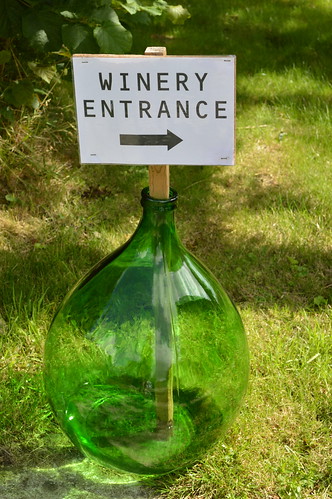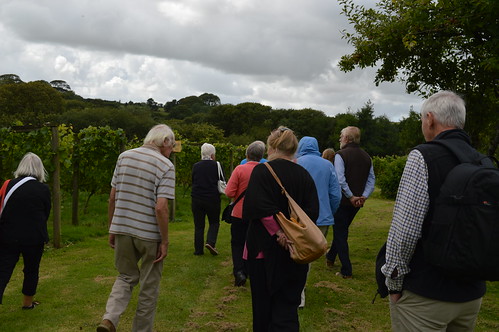Report on mid-August 2014 Meeting Bosue Vineyard The wine Group had a very interesting trip to Bosue this week. We were given a fascinating insight into the life of a small vineyard by Paul Sibley who willingly answered our many questions and gave us a tour of the vineyard and cellar. As ever we finished with a delicious tasting of Paul's sparkling, white and rose wines. Report on meeting Monday 30th June 2014 Another wonderful sunny afternoon as the group sat in Helen's newly redesigned garden and sampled a couple of Riesling wines. Both wines came from Morrisons in Bodmin. Firstly we tasted a McGuigan Classic Riesling. This wine normally retails at £8-99, but is currently on offer at £5-99. The second wine sampled was Morrisons Signature Mosel Riesling, costing £6-99. More information, unashamedly lifted from Morrisons website, as follows: - McGuigan Classic Riesling "When you think of Riesling you tend to think of Germany, but this tasty tipple comes from Down Under. Yes, those fine winemakers at McGuigan have produced their own classic Riesling and packed it with flavour as only they know how. Some might think that Riesling grapes only flourish in cooler climes, but not so; the warmer Aussie weather creates a lovely dry wine, with the delicate aroma of elderflowers and a good punch of green apple and zesty lime. You really must try this wine with a fragrant Thai curry as the flavours go together perfectly. In fact, it's pretty tasty with just about anything and that makes it a really good wine to have chilling in the fridge, ready and waiting." Morrisons Signature Mosel Riesling 75cl"This classy German Riesling boasts apple and apricot flavours galore. This deliciously fruity wine's fruity taste is all wrapped up with a hint of rose petal fragrance and a crisp lemon and lime finish.Germany's cooler growing conditions are perfect for developing the characteristics of the tasty Reisling grape, which is why the country has been making some great white wines since Roman times. No surprise then that the Germans seem to have now honed the art and science of producing the perfect Mosel Reisling. The result? A deliciously complex tipple bursting with buckets of lemony acidity and apricot and apple flavours with a whiff of rose petal that really surprises. Serve it nice and cool and it's a great match for delicate white fish and salads." Both wines were well received by the group. Most members present could detect a hint of apple and lime in the Australian Riesling, which overall had a dry fruity taste. The group though the second German wine was very sweet and better suited as an accompaniment for a light pudding, such as a fruit salad, rather than fish as suggested by the supplier. The group were surprised by the low alcoholic content of this wine, only 8%. Overall both wines were considered to be very acceptable and ideal for drinking on a sunny afternoon whilst admiring Helen's new garden. Thanks to Helen for arranging and hosting the afternoon. Keith Southgate (2nd July 2014) Linden Reports:- Istarted with two wines to sample. I had bought these in France earlier thisyear. Both these wines were Chardonnay, and both produced by Jean-Marc andJulien Brocard. Lastweekend I found another wine, from the same family, and available to buy atSainsbury’s in Bodmin. Ihave not yet tried this wine. I hope we will enjoy all three.
The Brocard Family
Jean-MarcBrocard trained as an agricultural engineer and then married the daughter of awine grower from a village near Chablis. Wine making started when, for awedding present, Jean-Marc was given a hectare of vines by his father-in-law.
Thefamily Brocard now has control of about 180 hectares of vines.
Jean-Marc’sson Julien started making biodynamic wine, following the ideas put forward byRudolf Steiner. Juliennow runs most of the family business. Allthe vineyards of the estate are being converted to biodynamic methods.
Thehouse style has been for maturation in stainless steel as the delicate aromasof Chablis are easily masked by barrels less than 4 years old. Forcertain wines they might use ‘foudres’ (large oak barrels) and they areexperimenting with concrete egg shaped vats. TheWine Society can supply a bottle of Jean-Marc Brocard’s Chablis Grand Cru, LesClos 2007 for £42.
Iapologise for not bringing any Les Clos wine today. Myonly offering from Les Clos is the small rock on the table.
Winenumber 1
KimmeridgienBlanc, Burgundy 2012 JeanMarc Brocard “Monvin puise arome en terre” (Mywine draws its’ flavour from the soil)
Seegeological notes below.
Winenumber 2
ChablisLa Boissonneuse 2010 JulienBrocard
Itwas with the Boissonneuse grapes that Julien Brocard first developed hisbiodynamic methods. This is where the winemaker is guided by the phases of themoon when working the vineyards.
Winenumber 3 Boughtin Bodmin, at Sainsbury’s.
Domaines Brocard Chablis Premier Cru Selection 2012 Label DomainesBrocard has created this excellent wine from grapes produced in the ChablisPremier Cru vineyards of Northern Burgundy. The Chardonnay grapes reach fullripeness here and the resulting wine has the classic, floral aromas of PremierCru Chablis with delicious citrus and mineral flavours on the finish. Servedlightly chilled it tastes best with fish, poultry or goat’s cheese. DomainesBrocard is proud to guarantee the quality of this wine and recommends it beconsumed within two years of purchase.
Sainsbury’sprice £16.00 (Asdaalso has a similar wine listed. Their price is given as £15.) Brocard’sown lists have 1st cru wines, prices ranging between £12 & £24. Wine Appreciation Geology - 26 May 2014
“Thereare grape wines, there are root wines. The first trusts in the sky, the secondfinds its flavours in the soil. I like these wines born in the soil.” Jean-Mark Brocard
Thefirst of today’s wines was created as part of a collection of three wines whichalso has a Portlandien and another Jurassic wine. I understand that thiscollection was originally brought together to illustrate the differencesbetween the types of soil in the Chablis area.
ThisKimmeridgian wine is not technically a Chablis, but I believe it originatesfrom nearby Auxerre.
Geologically,the land around Chablis was laid down in the Upper Jurassic era, over 135million years ago. Theupper layers (mainly towards Auxerre) are formed from the harder Portlandienrocks (as found around Portland, Dorset) whilst the Chablis area has more ofthe Kimmeridgien rocks (named after the village of Kimmeridge also in Dorset). Belowthe Kimmeridgian there is an Oxfordian strata.
Kimmeridgiandeposits are made up of layers of limestone (softer than Portland stone)alternating with clay. Many fossils were laid down within these deposits.
Shortlyafter I first visited Kimmeridge Bay, in Dorset (1958) an oil pump wasinstalled in the area. Oil is still being pumped now in small quantities. Itis the Kimmeridgian deposits under the North Sea that give us North Sea oil(and gas). Iassume it is the same geological formation which is drawing the attention ofthe oil producers who want to ‘frac’ areas in southern England to extract oiland gas! InFrance fracking is illegal! Report on meeting Monday 28th April 2014 Alan had chosen Chardonnay as our theme this week. The first wine a classic French use of Chardonnay .... a Chablis from Bouchard Aine & Fils. Many of us admitted to being 90's Chardonnay drinkers who had recently been put off by the over oaked versions of this wine which flooded the market. When the Chablis bottle arrived though we all smiled and enjoyed the steely nose of the wine. We mostly felt it could be a little drier but we all enjoyed the extra portions due to the smaller than usual group. The second wine was a new one to us all, recommended by Alan's son who had worked at Wadebridge Wines. Umbrele Chardonnay comes from Romania. The name means shadow in Romanian and refers to the vineyard being in the shadow of the Carpathian Mountains. We were all impressed with the quality and flavour of the wine given that it retails at around £7 a bottle. Our thanks to Alan for an interesting afternoon, and for re-introducing some of us to the joys of Chardonnay! Report on meeting Monday 31st March 2014 A slightly smaller group than usual (6) met at Lin & Rob Briggs cottage in Lerryn, braving the rain and mud in Piggy Lane. We tasted two wines, the first a Ca’Bolani DOC semi-sparkling Prosseco which turned out to be fairly unremarkable. This wine is available from Laithwaites. We discussed the renaming of the original Prosecco region to “Glera” (we assumed the marketing men missed this meeting!), and the uplifting of the designation of the original DOC to DOCG. The second wine was a 2009 La Fraccion, Seleccion de Barrica, Malbec from the Mendoza region of Argentina, which everyone loved. It is available from www.pampaswines.com . The wine is full bodied with hints of blackberries and raspberries and is deliciously smooth with notes of oak and slightly aromatic. This wine is grown on a small vineyard owned by Rob & Lin’s friends Sue & Malcolm Smith, who some may remember, used to own and run the village shop in Lerryn.” For more information see http://www.pampaswines.com/la-fraccion-malbec-seleccion-de-barrica-2009.html Report on meeting Monday 24th February 2014 This week the Group tasted two desert wines
More information about these wines below. Hermits Hill,Botrytis Semillon 11% Australia (NOW £7-99) These inexpensiveand usually delicious little Botrytis dessert wines from Australiacan be great bargains: at only £6.99 it wouldn't be a greatsacrifice to stick one of these wines in the fridge to match withmid-week cheeses or the stickiest desserts. Made for M&S by deBortoli, it has a fine barley sugar and gentle figgy nose, with sometoast and little dried apricot fruit. On the palate there's some realjuicy life about this with a cut of apple and of lemon, but nicelyjudged Botrytis adding rich notes and a medium-bodied texture as wellas balanced sweetness. £6.99 per 37.5cl. Available online in casesof six half-bottles from marksandspencer.com Croix MilhasRivesaltes Ambré 37.5cl (Half Bottle) 16% Tesco £4-99 (On Offer) Rivesaltes Ambre winesare made predominantly from Grenache Blanc, Grenache Gris, Maccabeuand Tourbat, with a smaller amount (20%) of Muscat Blanc or Muscat ofAlexandria also permitted. Subjected to a minimum of two years'oxidative ageing, they are deep golden-yellow in their youth, witharomas of sweet nuts and caramelized citrus fruits. As they age, thegold color deepens and moves towards orange, amber and eventuallyreddish-brown. Location:Rivesaltes is situated in the Pyrenees-Orientales(Languedoc-Roussillon region) in the south of France at 8 km fromPerpignan, the department capital. (General information: Rivesaltesis 678 km from Paris). More about desert wines at wikipedia * 2014 began in style for our Wine Appreciation group when we blind tasted "bubbles" at our January meeting. We started with some entertaining banter about the shape of champagne coupes. Legend has it the shape of the glass was modelled on the breast of Marie Antoinette, Joséphine de Beauharnais, Madame de Pompadour, or one of several other French aristocrats. Nowadays we prefer a champagne flute. The bowl is designed to retain champagne's signature carbonation, by reducing the surface area at the opening of the bowl. The flute has largely replaced the champagne coupe or saucer, the shape of which allowed carbonation to dissipate even more rapidly than from a standard wine glass. Nucleation in a champagne glass helps form the bubbles seen in champagne. Too much nucleation will cause the carbonation to fizzle out quickly. A smoother surface area will produce fewer bubbles in the glass, and more bubble texture in the taster's mouth. Our first glass was pronounced to be very palatable by the group. Quite dry, smallish bubbles, quite an apple aroma...... The second glass was much drier and only to the liking of two of the group. The first was Prosecco, the second was Nicholas Feuillate Brut Champagne For more information on Prosecco see More about Prosecco |
Wine Appreciation >










